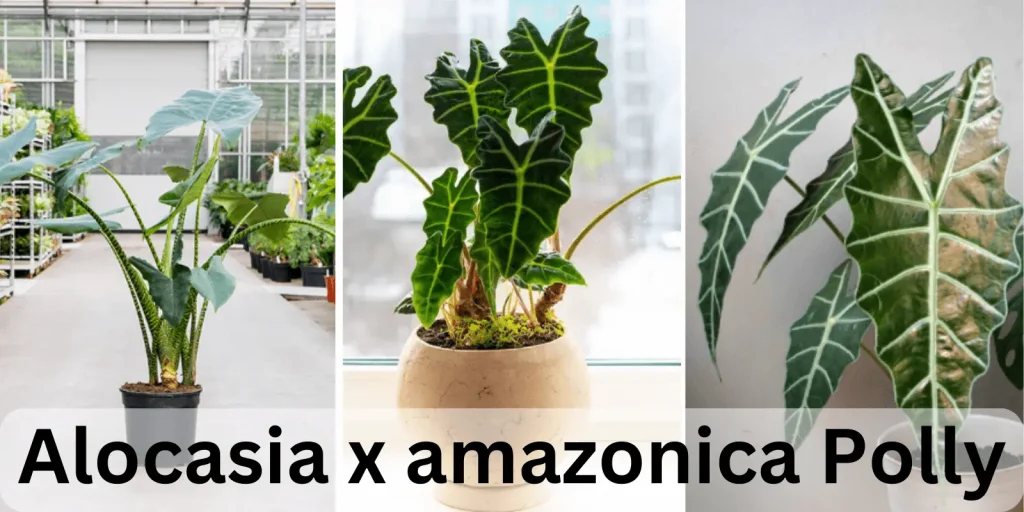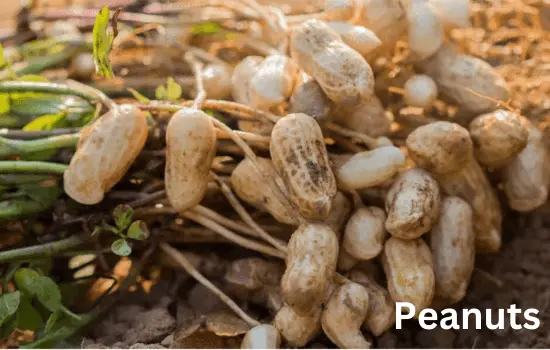Alocasia Polly | How to Grow and Care | Beginners’ Guide before buying
Alocasia Polly is an indoor plant with glossy, dark green big leaves, striking colors with white veins underside. Its graceful and eye-catching appearance makes it stand out from all pot plants. Moreover, it is easy to care and is the best choice for novice gardeners.
It got its name Alocasia x Amazonica ‘Polly” as it is a hybrid of these two parent varieties. It is a product of cross-breeding these two species, Alocasia watsoniana and ALocasia sanderiana. It was developed in 1950 in the Amazon Nursery. These parents were common in Asian countries and Australia.
A plant with glossy shining leaves and plant size makes it the perfect indoor plant. It takes less space and thus can be placed on the table, desktop, and anywhere in the window. It adds aesthetic value to the room and purifies the air from chemicals, e.g., formaldehyde.

Before learning more about the different aspects of the plants, let’s look at some facts about them.
Facts about Alocasia Polly (Alocasia x Amazonica)
| Common Name | Alocasia Polly or amazonica Polly, or Afrian Mask plant, Amazonian Elephant’s Ear |
| Scientific Name | Alocasia x amazonica Polly |
| Family | Araceae (Elephant Ear Family) |
| Origin / Native Area | South Asia |
| Plant Type | Annual (Bulb) |
| Soil Type | Slightly Acidic (5.5 6.5 pH) |
| Suitable Temperature | 18°C – 27°C |
| Fertilizers | Apply liquid fertilizers once in a month |
| Plant Height | 12-35 inches |
| Bloom Time | Early Summer |
| Bloom Colour | Creamy, Pale Green |
| Toxic Compound | Calcium Oxalate crystals |
| Hardiness Zones | 10, 11, and 12 USDA (United States Department of Agriculture) |
How do you care for the Alocasia Polly Plant?
The plant is easy to care for. However, it is tender, soft, and a little fussy; thus, sometimes, a little delay in irrigation and dehydration cause wilting and die-off. As the plant is a hybrid from the rainforest parents, thus providing similar moist conditions, frequent irrigation, indirect light, and well-drained soil with organic matter would be perfect. Consider the following conditions before going to buy these plants.
Suitable Location
The best placement position of the pot containing the plant could be near the southern-facing window or in the greenhouse with a sufficient light source and optimum temperature. You need to control the humidity of the room as well.
With controlled temperature by the thermostat and using a humidifier, you can also place this Alocasia Polly in your room. For optimum humidity, you can place it near the kitchen or bathroom or with a tray of pebbles and water in it.
Best Soil
Alocasia is a hybrid species that is a member of the rainforest family. It requires moist, well-drained soil. You can make this mixture of the soil yourself by adding soil, peat, perlite, organic matter, and composted leaves. However, soil mix is also available with plenty of air pockets and is suitable for plants like Polly.
How do you make your productive soil mix?
DIY-ing will save you money, and you will love it. For this, take 1 part soil, 1 part perlite, 3 parts orchid bark, 2 parts of well composted moss, and 1 part of coco coir. Mix them well and leave them covered for 4 – 7 days. Get back and fill in the pots. Press gently and make a hole to place your plant in it.
Water and Humidity
The plant is from tropical rainforests, and thus, it requires ample moisture and humidity. You can provide all this by frequent irrigation. The soil must be moist all the time. Always check for the moisture content of the soil with your finger. If the top 23 inches of soil is dry, use sprinkler irrigation.
Keep noticing the drainage hole blockage. Setting your Alocasia in moist and flooded soil can cause disease. Submerging the roots in water will deprive them of the air, and they will start rotting (root rot). You can manage all this manually by just observation.
How to Water Alocasia Polly?
The plant is from a hot and humid rainforest origin; thus, it is needed to keep the soil moist for most of the time. Light and frequent irrigation would work perfectly for it. Use a sprinkler or a hand sprayer to keep the top 2.5 cm of the soil moist and saturated.
Always ensure that the top soil has dried before the application of water. This will help avoid excessive moisture and flooded conditions that cause root rot.
Alert
Alocasia plants are sensitive to chlorine content in the water. Get your tap water tested before applying to the Alocasia Polly pots. If chlorine traces are in the water, let these contents sit at the bottom before applying.
Apply frequent irrigation in summer; in winter, you can use a sprinkler or sprayer. You can create a mini rainforest environment for your plant in the greenhouse with a humidifier and pebble-filled water trays.
Indirect Light
In the rainforest, the parents of this hybrid grow well under the shade in indirect sunlight. Keep providing the same situation to this plant in rooms and greenhouses. The light requirements of the plants are bright but indirect.
Please place them in the windows facing towards the northern east for better and softer light in the morning. You have to do this as direct sunlight can bleach out the green color of the leaves. Moreover, if you plan to place it near the window, please use a sheer curtain to block dangerous light rays.


Pro TIp
If the leaves are dusty, shower the plant and use a soft cloth to wipe out all the dust and water from the leaves.
Liquid Fertilizers
Applying liquid fertilizer or fertigation (water mixed with fertilizer) can help gain better growth. The plant blooms throughout the year and thus requires nutrients every month. You can apply fertilizers twice in winter and spring. Check for fertilizer constituents if the plant is not flowering.
For fertigation, use a 10% solution of NPK-containing fertilizers. However, if your plant is diseased or has an attack of pests, don’t apply fertilizers, as fertilizers may put some extra stress on it. Once it is recovered, apply more fertilizers.
Cutting and Pruning
The plant may have yellow and brown spots in soggy and water-logged conditions. These spots would grow bigger, turning the whole leaf brown. These leaves fade away the beauty of the plant. You can prune these leaves. Use a sharp scissor or a shear tool to prune these leaves.
Propagation by Vegetative Means
The plant produces pups and vegetative reproductive parts. In early spring, these pups serve as the propagation agent. Moreover, the rooting part, the rhizome, will also serve as a vegetative part for propagation.
How to Repot Elephant Ear Alocasia Amazonica?
If you have got this plant in a larger container, you don’t need to report it due to excessive growth. However, if the pot size is small and not robustly growing, you need to refresh the soil and the pot. Preferably do this in early spring. Follow the following directions;
- Use a pot one size larger than the present pot. A container that is too big may cause soggy conditions.
- Check for the drainage hole of the pot.
- For the larger pot, try to use pots made up of clay rather than plastic. The clay pot dries quickly.
- Fill the soil as mentioned above in the soil section. Use soil mix or prepare it yourself and add.
- Press the soil or soil mix in the pot gently and make room for the new plant with a stick or your finger.
- Moist the soil with light irrigation and let the water drain.
- Repot the plant and press the soil near the root zone gently.
- Place the pot in indirect soil.

Common Problems of Alocasia x Amazonica Polly
The plant is easy to grow but may face some problems. All these diseases, pests, and troubleshoots are due to keeping the plants unattended for a long time.
Disease and Pests
Following diseases may attack
Root Rot
Problem: Leaves turn yellow and droopy, and the plant can be easily pulled off.
Solution: Cut off the black roots and repot your plant.
Leaves Curling
Problem: This issue has its roots in intense light and drought. The plant may show leaf curling if it lacks the optimum humidity (35-40%).
Solution: Reschedule your watering.
Leaf Yellowing
Problem: The leaves are limp and yellow due to over-watering.
Solution: Trim the yellow leaves and stop irrigation.
Brown edges
Problem: The application of too much water, flooded conditions, and soil being not well-drained may cause soggy and leggy conditions. This will result in brown spots, and the plant will die completely in a few weeks. This will result in root rot.
Solution: Stop frequent irrigation. Repot your plant in well-drained soil.
Leaves falling
This happens in winter, and this is not a problem. If the leaves of the Alocasia are fading away, reduce watering.
Common Pests
Pests: Spiders, mites, bugs, and other sucking insects attach in moist conditions. This will result in yellowing of the leaves.
Solution:
- Visit your plant daily.
- See the insects underside the leaves for any infestation.
- Spray any insecticide after consultation.
FAQs
I’m Dr Qaiser Maqsood (PhD), a dedicated researcher and expert in Biological Sciences, Gardening, Bio-Diversity, Ecology, and Environmental Sciences. I’m much concerned about Environmental Pollution, Climate Change, Plantation, Gardening, and Global Warming. My passion is to explore innovative solutions in all these fields.
Be aware that we have ONLY ONE EARTH. Protect it!!






